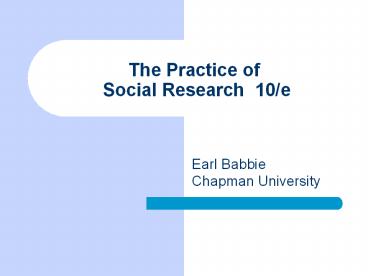The Practice of Social Research 10/e - PowerPoint PPT Presentation
Title:
The Practice of Social Research 10/e
Description:
The Practice of Social Research 10/e Earl Babbie Chapman University Chapter 1 Human Inquiry and Science Chapter Outline Looking For Reality The Foundations of Social ... – PowerPoint PPT presentation
Number of Views:1126
Avg rating:3.0/5.0
Title: The Practice of Social Research 10/e
1
The Practice of Social Research 10/e
- Earl BabbieChapman University
2
Chapter 1
- Human Inquiry and Science
3
Chapter Outline
- Looking For Reality
- The Foundations of Social Science
- Some Dialectics of Social Research
- The Ethics of Social Research
4
How We Know What We Know
- Direct Experience and Observation
- Personal Inquiry
- Tradition
- Authority
5
Looking for Reality
- Two Criteria
- Logical support - must make sense
- Empirical support - must not contradict actual
observation
6
Ordinary Human Inquiry
- Humans recognize that future circumstances are
caused by present ones. - Learn that patterns of cause and effect are
probabilistic in nature. - Aim to answer both what and why questions,
and pursue these goals by observing and figuring
out.
7
Things Everyone Knows
- Sources of our secondhand knowledge
- Tradition
- Authority
- Both provide a starting point for inquiry, but
can lead us to start at the wrong point and push
us in the wrong direction.
8
Errors in Inquiry and Solutions
- Inaccurate observations
- Measurement devices guard against inaccurate
observations and add a degree of precision. - Overgeneralization
- Commit to a representative sample of observations
and repeat a study to make sure the same results
are produced each time.
9
Errors in Inquiry and Solutions
- Selective observation
- Make an effort to find deviant cases that do
not fit into the general pattern. - Illogical Reasoning
- Use systems of logic consciously and explicitly.
10
Views of Reality
- Premodern - Things are as they seem to be.
- Modern - Acknowledgment of human subjectivity.
- Postmodern -There is no objective reality to be
observed.
11
Foundations of Social Science
- Theory - logic
- Data collection - observation
- Data Analysis - comparison of what is logically
expected with what is actually observed
12
Social Regularities
- Examples of Patterns in social life
- Only people aged 18 and above can vote.
- Only people with a license can drive.
13
Aggregates
- The collective actions and situations of many
individuals. - Focus of social science is to explain why
aggregated patterns of behavior are regular even
when individuals change over time.
14
Variables and Attributes
Variable Attribute
Age young, middle aged, old
Gender female, male
Occupation doctor, laborer, teacher
Social Class upper, middle, lower
15
Education and Racial Prejudice
Percent saying Black-Americans have less in-born ability to learn Level of Education
Less than high school graduate 27
High school graduate 13
Junior college 9
Bachelors degree 5
Graduate degree 2
16
Approaches to Social Research
- Idiographic - Seeks to fully understand the
causes of what happened in a single instance. - Nomothetic - Seeks to explain a class of
situations or events rather than a single one.
17
Approaches to Social Research
- Induction Moves from specific observations to
the discovery of a pattern that represents order
among all the given events. - Deduction - Moves from a pattern that might be
logically or theoretically expected to
observations that test whether the expected
pattern occurs.
18
Approaches to Social Research
- Qualitative Data Nonnumerical data
- Quantitative Data -Numerical data, makes
observations more explicit and makes it easier to
aggregate, compare, and summarize data.
19
Approaches to Social Research
- Pure Research - Sometimes justified in terms of
gaining knowledge for knowledges sake. - Applied Research Putting research into practice.































